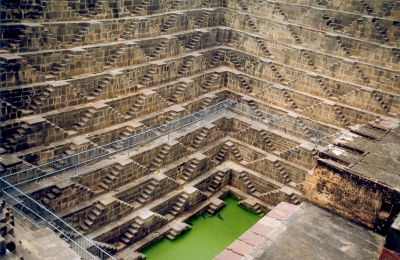
Chand Baori is a spectacular step-well in Abhaneri village, Rajasthan. Built by King Chanda of the Nikumbha Dynasty between 800 and 900 AD it was dedicated to Hashat Mata, goddess of joy and happiness. Along the walls on three sides are double flights of steps, 3,500 of them descending to the bottom of the well 20 metres deep. The fourth side has a set of pavilions built one atop another. There is even a royal residence and a stage for the performing arts. It was intended to conserve as much water as possible. At the bottom of the well, the air remains 5-6 degrees cooler than at the surface, and Chand Baori was used as a gathering place for locals during periods of intense heat.
Built in the ninth century but reminiscent of an Escher drawing, Chand Baori is among the largest and most elaborate of India’s many stepwells. The four-sided Chand Baori is 13 stories tall, 100 feet deep, and lined with 3,500 steps arranged in a spectacular zig-zag pattern. On one side of the well is a temple dedicated to the Hindu goddess Harsiddhi. Its intricate, multilevel facade overlooks a small pond of bright green water: a reminder of the magnificent structure’s practical purpose. The construction dates to the 10th century and is dedicated to Harshat Mata, goddess of joy and happiness.
The use and conditions of stepwells began to decline in the years of the British Raj, who were horrified by the unsanitary conditions of these drinking water bathing spots. They began to install pumps and pipes, and eventually outlawed the use of stepwells in some places.
The remaining stepwells are in varying states of preservation, and many have gone dry. Local kids find the ones with water to be excellent diving spots.
Credit : Slate
Picture Credit : Google




